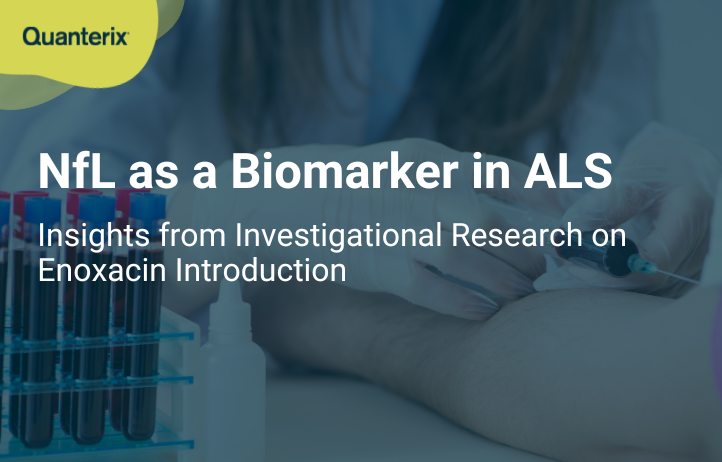
NfL as a Biomarker in ALS: Insights from Investigational Research on Enoxacin
Introduction
ALS is a fatal neurodegenerative disease that progressively impairs motor function, leading to paralysis. Current treatments focus on symptom management, with tofersen recently approved as the first disease-modifying therapy for SOD1-ALS.1
Tofersen’s accelerated approval, based on its ability to reduce plasma neurofilament light (NfL) levels, highlights the growing role of blood-based biomarkers in neurology trials. As the search for broader ALS treatments continues, enoxacin is emerging as a promising candidate.
A recent Phase Ib/IIa trial demonstrated enoxacin’s safety, tolerability, and biomarker effects, paving the way for further research. This study reinforces the importance of biomarkers like NfL in driving breakthrough therapies for neurological diseases.2,3
Expanding ALS Treatment: The Potential of Enoxacin
In April 2023, the FDA granted accelerated approval to tofersen for SOD1-ALS based on its ability to reduce plasma neurofilament light (NfL), a key biomarker of neuronal damage. While tofersen preserves function and suggests sustained improvement, it benefits only about 2% of ALS patients with the SOD1 mutation, leaving a critical need for broader treatments.
Enoxacin, a fluoroquinolone antibiotic, has shown promise in preclinical studies by enhancing DICER activity—a key enzyme in miRNA maturation. Given the miRNA deficiencies and DICER downregulation observed in ALS, researchers hypothesize that enoxacin may offer a novel disease-modifying approach.
Study Overview: Enoxacin ALS Clinical Trial Design and Objectives
This clinical study was designed to evaluate the safety, tolerability and pharmacodynamic effects of enoxacin in patients with ALS. Eight individuals with sporadic ALS were enrolled and received varying doses of oral enoxacin twice daily for 30 days. The primary endpoints evaluated the safety and tolerability of enoxacin, while secondary outcomes included the measurements of total miRNA levels and NfL concentrations in plasma and in cerebrospinal fluid (CSF).
Analytical Approach for NfL
NfL concentrations were measured using the Simoa® NfL Advantage Assay Kit on the Quanterix SR-X® Biomarker Detection System, a semi-automated benchtop instrument powered by Simoa digital immunoassay technology. The SR-X delivers ultrasensitive biomarker quantification in a compact, cost-effective system, enabling precise analysis of key neurological disease markers like NfL.
Key Findings from Enoxacin ALS Biomarker Trial
Enoxacin was safe and well tolerated in ALS patients
While enoxacin has been in clinical use for many years as an antibiotic, this trial aimed to evaluate the drug’s safety and tolerability in ALS patients with orally administered 200, 400 or 600 milligrams twice a day over a 30-day period. Overall, patients did not experience any serious adverse events during the trial period, supporting enoxacin’s safety profile in this population.
Enoxacin increased total miRNA levels in both plasma and CSF, further confirming target engagement
Quantification of total miRNA in plasma and CSF demonstrated that treatment with enoxacin increased miRNA levels, correlating with plasma enoxacin concentrations. These findings suggest that orally administered enoxacin enhances miRNA biogenesis in the central nervous system (CNS).
Enoxacin upregulated several neuroprotective miRNAs, supporting its proposed mechanism of action
In addition to total miRNA levels, miRNAs linked to neuronal survival, neuroinflammation suppression, and ALS-associated pathways—including miR-139, miR-130a, let-7c, and miR-378a—were notably upregulated.
Positive efficacy signals and the essential role of NfL as a biomarker in future enoxacin trials
Although this trial was not designed to assess efficacy, changes in miRNA biomarkers suggest that longer treatment may impact disease progression. Over the 30-day study period, NfL levels in both plasma and CSF remained stable, indicating that a longer duration may be needed to evaluate enoxacin’s effect on neurodegeneration. For comparison, the tofersen trial showed a 40–50% reduction in NfL levels over six months, reinforcing the importance of including NfL biomarker measurements in extended studies.
Implications for ALS research
With its potential to restore miRNA levels, enoxacin offers a promising complementary approach to existing ALS treatments—bringing new hope to patients. The results from this trial confirmed that enoxacin is safe, well-tolerated, with potential to modulate miRNA biogenesis in blood and CSF. These findings pave the way for larger, long-term studies to assess its potential as a disease-modifying therapy, with NfL dynamics as a key biomarker for therapeutic development.
Empowering ALS research and clinical studies with blood-based neurology biomarkers
The inclusion of NfL measurement as a secondary endpoint highlights the growing acceptance of the utility of blood-based biomarkers in neurology therapeutic trials. In the case of tofersen, the reduction of NfL levels provided critical evidence of the drug’s efficacy, with the FDA Advisory Committee unanimously voting that the reduction in plasma NfL is likely to predict clinical benefit of the drug for SOD1-ALS patients.
This was among the first commercial assays to enable blood-based NfL quantification, paving the way for hundreds of peer-reviewed studies across preclinical, translational and clinical research.
References:
- QALSODY® (Tofersen)| Official Patient site
- Magen I, Kaneb HM, Masnata M, et al. A phase Ib/IIa randomized trial of Enoxacin in patients with ALS. medRxiv. 2024 Aug 1:2024-07. doi: https://doi.org/10.1101/2024.07.31.24311258